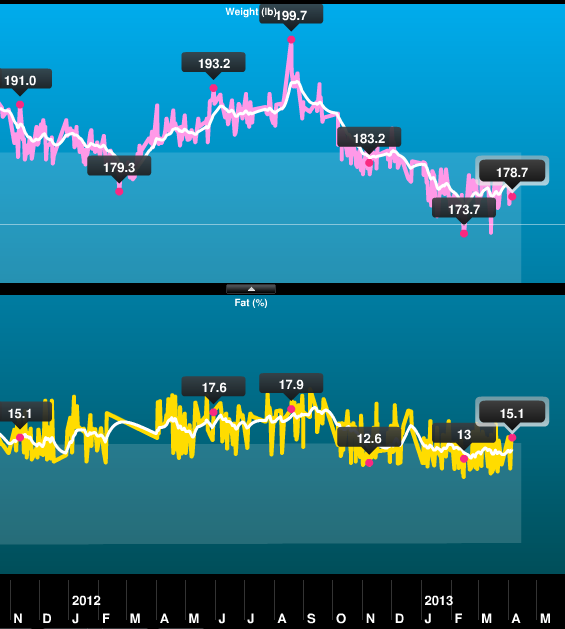Earlier today, I read a post by Daniel at Needless Pounds where he references a Full Body Sensor Monitor Scale. I commented about their lack of accuracy, but wanted to follow-up on my comment with data justifying my claim. This argument is based on data I’ve personally collected over the last few years.
On my birthday in 2010, I was given a Withings scale and have used it to keep track of my weight, body-fat percentage, and BMI ever since. I love this scale and the service for its ambient data collection; only a minute a day and I have a database of my measurements going back almost three years. In 2011, I read 4 Hour Body and decided to have a DEXA scan taken. (If you’re in Chicago, check out DexaFit. Affordable with a knowledgeable team and reports showing progress between visits.) From DexaFit’s website, DEXA works because
… the attenuation of x-rays with high and low photon energies is measurable and dependent on the thickness, density, and chemical composition of the underlying tissue. This attenuation (weakening) of x-rays through fat, lean tissue, and bone varies due to the difference in the densities and chemical compositions of these tissues. What does this all mean? The DXA scan accounts for your body’s tissue variations and accurately measures: fat mass, lean mass, bone mineral content, bone mineral density, percent fat, and regional values.
Compare this to bioelectrical impedance, the method used by these so-called “smart scales” to estimate body fat percentage.
BIA [bioelectrical impedance] actually determines the electrical impedance, or opposition to the flow of an electric current through body tissues which can then be used to calculate an estimate of total body water (TBW). TBW can be used to estimate fat-free body mass and, by difference with body weight, body fat.
In short, DEXA directly measures body mass while BIA is a body-fat estimate based on total body water, which varies depending on your level of hydration at the time of testing. Many claim, though, that BIA is still a useful tool for an individual to track changes in their body-fat percentage over a long period of time. Let’s look at my personal data to see if this is true.
Since my first scan, I’ve had two more DEXA scans and continued to use my Withings scale regularly. Here the results of the Withings scale are compared to the DEXA scan.
Notice the 9% drop in body-fat between September 2011 and March 2013 in the DEXA report. Compare this to my Withings records. The reported body-fat percentage fluctuates rapidly, almost week-to-week and much more rapidly than my weight, but on average has remained around 15-16%.
Based on this graph, my body-fat percentage today is the same as it was in November 2011, around 15%. In truth, however, it was around 26% in Nov 2011 and has since dropped to 17%. This is a very significant change in body-fat. The fact that this device can’t detect such a large change means that the argument that its useful to individuals for tracking changes over time is invalid.
Bottom line: buy a smart scale for automatic weight tracking, but not for measuring your body-fat percentage.



Thanks for the very detailed write-up, Cody! The extent of my experience with body fat measurements comes from only using the tools at the weight loss clinic, which are based on BIA. I’ve never had a DEXA scan.
DEXA scans are awesome, but from everything I’ve read, clinical BIA devices are far more accurate and consistent than consumer-grade ones like those built into scales. And far cheaper per use, I’m sure, as each scan costs me $90. (Of course, I’m paying per scan rather than through a routine program or anything.)